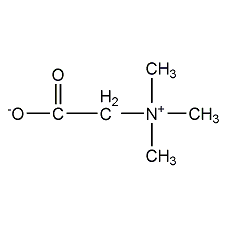Betaine Betaine


Structural formula
| Business number | 02V9 |
|---|---|
| Molecular formula | C5H11NO2 |
| Molecular weight | 117.15 |
| label |
betaine, betaine, betaine anhydrous, Trimethylhydroxymethylammonium, (Carboxymethyl)trimethylammonium inner salt, Oxyneurine, Antioxidants and fungicides |
Numbering system
CAS number:107-43-7
MDL number:MFCD00012123
EINECS number:203-490-6
RTECS number:DS5900000
BRN number:3537113
PubChem number:24891663
Physical property data
1. Properties: Colorless crystals or white crystalline powder, odorless and sweet.
2. Density (g/mL, 20℃): 1.00
3. Relative vapor density (g/mL, air=1): Undetermined
4. Melting point (ºC): 301-30
5. Boiling point (ºC, normal pressure): Undetermined
6. Boiling point (ºC, kPa): Undetermined
p>
7. Refractive index (D20): Not determined
8. Flash point (ºC): Not determined
9. Specific rotation (ºC): Undetermined
10. Autoignition point or ignition temperature (ºC): Undetermined
11. Vapor pressure (mmHg, 20ºC): Undetermined
12. Saturated vapor pressure (kPa, ºC): Undetermined
13. Heat of combustion (KJ/mol): Undetermined
14. Critical temperature (ºC): Undetermined
15. Critical pressure (KPa): Undetermined
16. Log value of oil-water (octanol/water) partition coefficient: Undetermined
17. Explosion upper limit (%, V/V): Undetermined
18. Explosion lower limit (%, V/V): Undetermined
19. Solubility: soluble in water, methanol, ethanol, slightly soluble in ether.
Toxicological data
1. Acute toxicity: subcutaneous LD50 in mice: 10800mg/kg; intravenous LD50 in mice: 830mg/kg;
Ecological data
This substance is slightly hazardous to water.
Molecular structure data
None
Compute chemical data
1. Reference value for hydrophobic parameter calculation (XlogP): 0.5
2. Number of hydrogen bond donors: 0
3. Number of hydrogen bond acceptors: 2
4. Number of rotatable chemical bonds: 1
5. Number of tautomers: none
6. Topological molecule polar surface area 40.1
7. Number of heavy atoms: 8
8. Surface charge: 0
9. Complexity: 87.6
10. Number of isotope atoms: 0
11. Determine the number of atomic stereocenters: 0
12. Uncertain number of atomic stereocenters: 0
13. Determined number of chemical bond stereocenters: 0
14. Uncertain number of chemical bond stereocenters: 0
15. Number of covalent bond units: 1
Properties and stability
1. Chloroacetic acid and trimethylamine in the chemical synthesis method are toxic, the equipment should be sealed, and the operators should wear labor protection supplies.
Storage method
Stored in a cool, ventilated warehouse. Keep away from fire, heat and water sources. should be kept away from oxidizer, do not store together. Equipped with the appropriate variety and quantity of fire equipment. The storage area should be equipped with emergency release equipment and suitable containment materials.
Synthesis method
(1) Extraction method. The mother liquor of beet sugar production contains 12%-15% betaine, which can be directly recycled. Heat 300 parts of the mother liquor to 50°C, add 80 parts of calcium chloride, stir for a certain period of time and then filter while hot. The filtrate is acidified with hydrochloric acid and then cooled to 20-30°C for crystallization. After separation and drying, about 30 parts of betaine are obtained.
(2) Synthesis method. Obtained from the quaternization of chloroacetic acid and trimethylamine.
Use 16% sodium hydroxide solution to neutralize 195 parts of 48.6% chloroacetic acid aqueous solution into sodium chloroacetate solution, and then mix with 360 parts of 16.4% trimethylamine The solution was mixed, aerated at 50°C for 1 hour, and then at 80°C for another 1 hour. The reactant was diluted and adsorbed by an ion resin (Dowex-50-8), and then eluted with ammonia water to obtain a betaine solution. The finished product is obtained through vacuum concentration and crystallization.
3.The mother liquor of sugar beet production contains 12% to 15% betaine, which can be directly recovered. It can also be obtained by quaternization of chloroacetic acid and dimethylamine.
Purpose
1. It has anti-tumor effect. It can be used as a flux in welding and in organic synthesis. It can be used as a hepatoprotective agent in medicine. This product can also be used in organic synthesis.
2.The addition of betaine to the feed can protect the vitamins in the feed, making the feed resistant to high temperatures and having a long storage period, which can greatly improve the quality of the feed. utilization rate and can also reduce costs. Adding 0.05% sweet alkali to chicken feed can replace 0.1% methionine; adding betaine to bait has a feeding attraction effect on fish and shrimp, and can be used in large amounts span style=”font-family:Arial;”>It is used as a puffing agent for aquatic products; adding betaine to pig feed can stimulate the appetite of pigs and increase the lean meat rate. 1kg betaine is equivalent to 3.5kg methionine. The ability of betaine to provide methyl groups is 1.2 times that of choline chloride and 3.8 times that of methionine.
